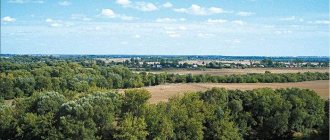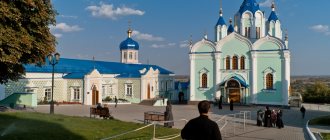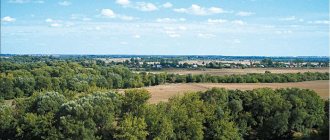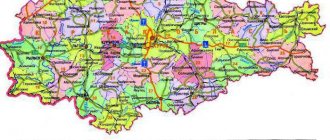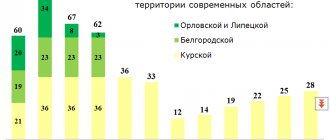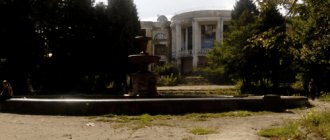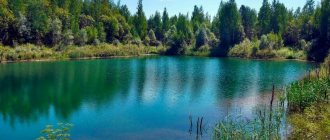Brief information about the municipality
Shchigry is a city of regional subordination. The city of Shchigry is located in the forest-steppe zone with the most favorable lands for agricultural production. The villages of Prigorodnaya and Kozlovka are located in close proximity to the city. See more>>
Geographical characteristics of the municipality
A map of the municipality is attached.
The city is located in the central part of the Central Russian Upland. The territory is a gently undulating elevated plain, intensively dissected by valleys of small rivers, ravines and gullies.
The Shchigor River flows through the city from west to east, 3-5 meters wide and 0.6 - 1.0 meters deep.
The climate of Shchigra is temperate continental. Sunny, long summers give way to relatively cold winters with stable snow cover; summer precipitation prevails over winter. The average annual precipitation is 584 mm.
A characteristic feature of the spring period is an extremely rapid rise in air temperature when cold air masses break through from the north.
The city is located on the border of forest and steppe zones, which created favorable conditions for the growth of both forest and steppe vegetation. The territory is occupied by natural vegetation, some of which are forests and shrubs.
The soil cover is represented by four main types of soil: chernozems, meadow-chernozem soils, floodplain swamp soils and soils of ravines and their slopes. Chernozems are most widespread. Meadow-chernozem soils, distributed mainly in the floodplains of rivers and streams, are most often clayey in their mechanical composition.
Floodplain-marsh soils, distributed in small areas along relief depressions in the floodplain, are used as hayfields and require reclamation.
The soils of ravines and their slopes are represented by washed-out and washed-out irregularities. These soils are currently occupied by trees, shrubs and meadow vegetation, which protects them from destruction.
The mechanical composition of the soil is heavy loamy. Agricultural the lands occupy about 30% of the territory of the urban district.
Outside the urban area, to the southwest and northeast of the central part of the city there are small forest tracts of natural origin: Baranovsky forest, Glinishche tract, Church Grove tract, Teterev forest tract and others, which are included in the green zone of the city and are suburban forest parks.
Etymology
The city got its name from the Shchigor River. In turn, the name of the river comes from the popular term shchigor
(plural
shchigra
) - “forested ridge of narrow inter-beam hillocks”[4][5].
Legends about the origin of the name
By the end of the 19th century the term Shchigor
has practically fallen out of use, so many legends have been born that “explain” the origin of the name of the river. Some of these legends were recorded by L. E. Markov:
- According to one legend, the word shchigor
comes from a Turkic curse, which was used by the Crimean Tatars when crossing the Shchigor, which during the existence of the Muravsky Way was a stormy and deep river. - According to another legend, in the vicinity of the river lived a terrible and elusive robber, whose name was Shchigor; The river was named after him.
Information about the leading enterprises of the municipality
The basis for the economic development of the city of Shchigry is industrial production, represented by three industrial enterprises: Geomash OJSC, the Shchigry branch of Kurskkhleb CJSC, and the Shchigry Bread Products Plant OJSC. In 2012, the city's industrial enterprises produced industrial products worth 2 billion 658 million. 112 thousand rubles, an increase compared to last year’s level of 33.5%. Additionally, industrial products were produced in the amount of 666 million 385 thousand rubles. In 2012, city enterprises produced:
| Drilling rigs | 251 pcs. |
| Bakery products | 2366.6 tons |
| Confectionery | 85.4 tons. |
| Dried lamb products | 821.6 tons. |
| Torment | 25787 tons. |
| Compound feed | 142878 tons. |
There was an increase in production volumes at Geomash OJSC, Shchigrovsky KHP OJSC, SOM OJSC, and Shchigrovsky Bakery OJSC. The growth of industrial production in the city occurred due to an increase in production volumes and a slight increase in product prices.
See more >> There are 6 organizations of the utility complex operating in the city: Shchigrovsky Utility Networks LLC, Shchigrovsky branch of Kurskgaz OJSC, Kursk Electric Networks OJSC branch, Quadra OJSC branch, Lyubimy Gorod Municipal Unitary Enterprise, Shchigrovskaya LLC housing and communal services management company.”
The number of workers in the public utilities sector is 398 people.
The average monthly salary is 12,764 rubles
On balance or in lease which have:
180.28 km of gas networks and 81 units of distribution devices;
210.7 thousand sq. m. of housing stock;
142 km of water supply, 20 km of sewerage networks;
7 heat supply sources and 16.73 km of heating networks that heat 144 thousand square meters. m. of housing stock and 27 social facilities;
190.4 km of electrical (of which 35.8 km are high-voltage) networks;
67 transformer substations;
There are a total of 91 streets in the city, the total length of which is 80.3 km.
As a result of the well-coordinated work of all utility workers, it is possible to avoid major accidents in gas, heat, water supply and sewerage systems, and start the heating season on time every year - from October 15.
In 2012, 88 million 800 thousand rubles were invested in the housing and communal complex from all sources of financing.
On the territory of the city of Shchigry the following is registered:
- 36 small enterprises, of which 8 are actively operating (in the field of construction, healthcare, consumer services and others)
- 484 individual entrepreneurs engaged in trading activities, providing personal services and public catering.
Today there are 180 trading enterprises of various forms of ownership in the city. Trading activities are carried out by 122 individual entrepreneurs and 23 legal entities, 12 public catering enterprises and 23 consumer service enterprises, of which 22 are individual entrepreneurs and one municipal enterprise - MUP "Rassvet".
There are two stores of the Magnit chain in the city, and there is one universal market in the central part of the city with an area of 8289 sq. m. m., there are fairs.
Over the past 2012, individual entrepreneurs opened 6 new trade enterprises in the city.
The entire population living in the city uses the services of passenger rail and road transport, the routes of which run through the territory of the city district.
Transport services for the population are provided by: JSC Shchigryavtotrans and three individual entrepreneurs.
The bus network is represented by three main routes: MSO-z/d plaza; “MSO-market (on Oktyabrskaya street).”
Healthcare in the city is represented by the regional budgetary healthcare institution “Shchigrovskaya Central District Hospital”.
The city's education system includes 15 institutions: vocational school -39, medical college, 4 secondary schools, 5 kindergartens, an art school, a children's and youth sports school, a home for pioneers and schoolchildren, a municipal methodological Center for additional pedagogical education, and a centralized accounting department of an educational institution.
1,510 children study in city schools, 815 children attend kindergartens, 1,200 students receive education in institutions for additional education for children.
There are cultural institutions in the city: the City House of Culture, the Aurora Palace of Culture, two libraries, a local history museum, a park of culture and recreation.
The social sphere of the city is represented by a comprehensive center for social services for the population and the Shchigrovsky psychoneurological boarding school.
The center of the spiritual life of the city is the Holy Trinity Church.
List of business entities in the city of Shchigry
List of city banks >>
List of city police leadership
List of city utility management
List of federal and regional institutions and organizations
List of preschool educational institutions in Shchigry
Social facilities on the territory of the municipality
Story
Fortress on Shchigra. Model-reconstruction of the Shchigry Museum of Local Lore Plan of the city of Shchigry (1782) Development plan of the city of Shchigry (1785)
Fortress on the Shchigor River
Troitskoye existed since the 17th century.
, which received its name from the Church of the Life-Giving Trinity located in it, at
the fortress on the Shchigor River
. The fortress was created to protect against attacks by the Crimean Tatars and was one of the rear fortresses in case of a breakthrough of the Belgorod line. There were no stone buildings in the fortress. By the end of the 18th century, the fortress completely lost its defensive significance and was razed.
From October 20 (Old Style) 1721 to September 1 (Old Style) 1917 as part of the Russian Empire.
XVIII century
In 1779, Shchigrovsky district was formed from the lands of the former Kursk, Livensky and Stary Oskol districts. The village of Troitskoye at the fortress on the Shchigor River received the status of a district town of Shchigry
. The number of inhabitants in the newly formed Shchigra was 807 people.
In 1780, the city’s coat of arms was established with symbols that reflected its historical merits - a gun and a sickle, meaning that “the inhabitants are ancient warriors who practice arable farming in their free time, and therefore in this coat of arms, a military weapon is combined with the tools of a careful cultivator.”
In 1785, a plan for the future city was approved. According to this plan, the new city was to be divided into 21 blocks with 8 streets; At the same time, the construction of three temples on three squares was envisaged. On the plan, the dotted line indicates a fortress on the left bank of the Shchigr, which by that time had already been razed.
By 1785 the number of inhabitants reached 1412 people. Houses - 233. The buildings are all wooden. There was one Church of the Life-Giving Trinity in the city. There were no factories or factories in the city. The area of the city was about 150 dessiatines (approximately 1.64 km²).[6]
19th century
Holy Trinity Church
In 1801, the stone Holy Trinity Church was built.
In 1802, the first educational institution, a small public school, was opened in Shchigra; in 1819, a district school and a city parish school were opened, preparing students for the district school.
In 1845 the population increased to 2,734 people. Most of the buildings were wooden one-story houses under thatched roofs.
By 1860, there were 371 houses in Shchigra. There were factories: 3 lard factories, 1 candle-tallow factory, 4 grain factories, 1 rope factory and 2 mead factories. Education was provided by district and parish schools. The population was 4,578 (2,409 men and 2,169 women).[7]
In 1865, the Shchigrovskaya Zemstvo Council was established - the executive body of the zemstvo.
In 1874, local government bodies were created in Shchigra: the city duma, the city public government, and the mayor was elected.
In 1875, on July 24, the Shchigrovsky City Public Bank of Major N.K. Barkov was opened with a founding capital of 10 thousand rubles. After 25 years, the bank’s turnover amounted to 1 million rubles.
In 1876, a telephone exchange appeared in Shchigra. In 1877, the Shchigrovsky zemstvo hospital was opened for those coming at the expense of the district zemstvo with 40 beds and an emergency room. The building of the hospital was destroyed during the Great Patriotic War.
In 1878, with donations from townspeople, a stone Church of the Ascension and an almshouse for poor parishioners were built in the Old Town.
By 1888, the central streets and Red Square were paved, sidewalks appeared in the city, and the issue of street lighting even on the outskirts was resolved.
In 1892, the Shcheglov Iron Foundry and Mechanical Plant (now Geomash) was transferred to Shchigry from the village of Snytkino.
In 1894, the Kursk-Voronezh railway passed through Shchigry. A railway station of the same name was established in Shchigry.
In 1899 a pro-gymnasium was opened, and in 1905 a women's gymnasium was opened.
XX century
Monument to the discoverers of the KMA on the central square of the city of Shchigry. Eternal flame and monument to those who died on Victory Square.
In 1908, the zemstvo library named after Evgeniy Lvovich Markov (a famous writer and a well-known zemstvo figure in Shchigry) was opened. Now this building houses a local history museum.
In 1910, a real school appeared in Shchigra. The district school is being transformed into a city school.
By 1914, Shchigry acquired the features of a typical county town, with a telephone, telegraph, pharmacy, fire station, hippodrome and city garden. A railroad passed through the city and there was a small mechanical plant. However, the industrial importance of the city was very small[8].
From September 1 (old style) to October 25 (old style) 1917 as part of the Russian Republic. Then the Russian Civil War of 1918-1923 began.
In the fall of 1919, during Denikin’s campaign against Moscow, the 3rd Markov Regiment and a detachment of Alekseevsky troops under Major General N.A. Tretyakov occupied Shchigry for a short time; the reserve of the 2nd Alekseevsky Regiment was stationed in the city. Already in mid-November, the 13th Army of the Red Army captured Shchigry, driving the White Guards out of the city.
In 1921, on the instructions of V.I. Lenin and under the leadership of academician I.M. Gubkin and mining engineer S.A. Bubnov laid the first well of the Kursk Magnetic Anomaly (KMA) 7 km from Shchigry. In Shchigry there is a street named after. Lazarev, named after academician P.P. Lazarev, the initiator of comprehensive intelligence of the KMA.
Since December 1922, as part of the Russian Soviet Federative Socialist Republic of the Union of Soviet Socialist Republics.
On April 7, 1923, the first core of Kursk iron ore was lifted from a depth of 162 meters. Due to the deep occurrence of the ore, the development was moved to other places (in which the cities were created: Gubkin and Zheleznogorsk).
In 1927, the Shcheglov mechanical plant, nationalized after the revolution, was repurposed and in 1927 produced the first KMA-300 drilling rigs.
In 1930, a mine based on the Shchigrovsky phosphorite deposit and a plant for their processing were put into operation.
In the period from 1930 to 1940, pedagogical and land management technical schools, a workers' school, a peasant university, a medical school, and a hospital complex were opened in Shchigra. There was a theater with 500 seats in the House of the Red Army, and summer theaters in the city and railway parks. There were 3 secondary schools.
The population of the city before the Great Patriotic War was about 8 thousand people.
On June 23, 1941, evacuation hospital EG - No. 1929 was deployed in Shchigra on the basis of the district hospital.
The city was defended by the 6th Infantry Division. In July-August 1941, the 283rd Infantry Division was formed in Shchigry[9]. Preparations began for the evacuation of the main enterprises (mechanical plant, metallurgical plant). The evacuation of production was completed in mid-November.
On November 21, 1941, Shchigry was occupied by Nazi troops.[10]
January 14 - 21, 1942, during the Kursk-Oboyan operation (January 3 - 26, 1942), fierce battles took place east of the city, during which the 87th Guards Rifle Division of the 40th Army unsuccessfully tried to liberate the city.
During the occupation, almost all enterprises and cultural institutions created in the pre-war years were destroyed.
On February 4 (February 5 [10]) 1943, Shchigry was liberated from Nazi German troops by Soviet troops of the Voronezh Front during the Kharkov offensive operation of 2.02.-3.03. 1943: [10]
- 60th Army (General Chernyakhovsky) consisting of: 132nd Infantry Division (Colonel Shkrylev, Timofey Kalinovich), units of the 121st Infantry Division (Colonel Bushin, Mikhail Alekseevich).[11]
The city of Shchigry was completely restored in the first post-war five-year plans.
In 1962, at school No. 2, history teacher Alexandra Nikolaevna Ivitskaya created the “Search” club. The collected documents, photographs, letters, books, things and other exhibits, as well as the memories of relatives, teachers and fellow villagers, served as the basis for the creation of a museum of military glory, which was opened in November 1967. The museum had sections: “History of the city and district”, “Establishment of Soviet power”, “Years of the Civil War”, “The Great Patriotic War”. Guides were prepared. The museum was visited by students from city and district schools, teachers and pioneer leaders, tourists from other regions, and veterans of the Great Patriotic War. A. N. Ivitskaya was awarded the title of Honored School Teacher of the RSFSR in 1971[12]. In 1977, based on materials collected for the museum of military glory, with the help of the regional museum of local lore, the Shchigrovsky museum of local lore was created [13], which operates to the present day.
Shchigry reached its highest point of development in the mid-1980s, when all enterprises (PO Geomash, reinforced concrete products plant, SOM plant, brick factory and others) were operating at full capacity, and the population exceeded 21 thousand people.
Since 1991, the Shchigry have experienced social and economic difficulties. Some enterprises have gone bankrupt, others are not operating at full capacity. The population is declining.
Notes
- ↑ 123
The permanent population of the Russian Federation by municipalities as of January 1, 2021 (Russian). Date accessed: April 27, 2021. Archived May 2, 2021. - THE USSR. Administrative-territorial division of the union republics on January 1, 1980 / Comp. V. A. Dudarev, N. A. Evseeva. - M.: Izvestia, 1980. - 702 p. — P. 157.
- Charter of the city of Shchigry
- Yashchenko A.I. Toponymy of the Kursk region. - Kursk, 1958.
- Prokhorov V. A. Inscription on the map. - Voronezh: Central-Chernozemnoe book. publishing house, 1977
- * Larionov S.I.
Briefly collected description of the Kursk governorship from ancient and new various news about it.
- Moscow: Ponomarev's free printing house, 1786. - P. 156-159. — 191 p. Archived copy (unspecified)
(inaccessible link). Date accessed: January 4, 2021. Archived July 11, 2009. - *Memorable book of the Kursk province for 1860. - Kursk: Provincial Statistical Committee, 1860. - 363 p.
- Shchigry // Encyclopedic Dictionary of Brockhaus and Efron: in 86 volumes (82 volumes and 4 additional). - St. Petersburg, 1890-1907.
- 283rd Rifle Division
- ↑ 123
Directory "Liberation of Cities: A Guide to the Liberation of Cities during the Great Patriotic War of 1941-1945." M. L. Dudarenko, Yu. G. Perechnev, V. T. Eliseev and others. M.: Voenizdat, 1985. 598 p. - Red Army website. https://rkka.ru Archived copy from September 30, 2021 on the Wayback Machine.
- State Archive of the Kursk Region (GAKO). F.R-4006. Op.3. D.2393. L.48-49
- State Archive of the Kursk Region (GAKO). F.R-214. Op.1.D.908. L.18)
- Archival data (Shchigrovsky Museum of Local Lore)
- Larionov, S.I.
Briefly collected description of the Kursk governorship from ancient and new various news about it. - Moscow: Ponomarev's free printing house, 1786. - P. 156-159. — 191 p. - Archival data (Shchigrovsky Museum of Local Lore)
- ↑ 1 2 3 4 5 6 7 8 9 10 11 12 13 14 15 16
People's Encyclopedia “My City”.
Shchigry (undefined)
. Retrieved June 1, 2014. Archived June 1, 2014. - Memorial book of the Kursk province for 1860. - Kursk: Provincial Statistical Committee, 1860. - 363 p.
- Kursk provincial statistical department. Population of the cities of Kursk province according to the censuses of 1920 and 1923. [Vol. 3]. - Kursk, 1927.
- All-Union Population Census of 1939. The size of the urban population of the USSR by urban settlements and intra-city areas (unspecified)
. Retrieved November 30, 2013. Archived November 30, 2013. - All-Union Population Census of 1959. The size of the urban population of the RSFSR, its territorial units, urban settlements and urban areas by gender (Russian). Demoscope Weekly. Access date: September 25, 2013. Archived April 28, 2013.
- All-Union Population Census of 1970 The size of the urban population of the RSFSR, its territorial units, urban settlements and urban areas by gender. (Russian). Demoscope Weekly. Access date: September 25, 2013. Archived April 28, 2013.
- All-Union Population Census of 1979 The size of the urban population of the RSFSR, its territorial units, urban settlements and urban areas by gender. (Russian). Demoscope Weekly. Access date: September 25, 2013. Archived April 28, 2013.
- All-Union population census of 1989. Urban population (undefined)
. Archived from the original on August 22, 2011. - All-Russian population census 2002. Volume. 1, table 4. Population of Russia, federal districts, constituent entities of the Russian Federation, districts, urban settlements, rural settlements - regional centers and rural settlements with a population of 3 thousand or more (unspecified)
. Archived from the original on February 3, 2012. - The size of the permanent population of the Russian Federation by cities, urban settlements and regions as of January 1, 2009 (unspecified)
. Retrieved January 2, 2014. Archived January 2, 2014. - All-Russian population census 2010. Volume 1. Number and distribution of the population of the Kursk region (unspecified)
. Retrieved January 31, 2014. Archived January 31, 2014. - Population of the Russian Federation by municipalities. Table 35. Estimated resident population as of January 1, 2012 (unspecified)
. Retrieved May 31, 2014. Archived May 31, 2014. - Population of the Russian Federation by municipalities as of January 1, 2013. - M.: Federal State Statistics Service Rosstat, 2013. - 528 p. (Table 33. Population of urban districts, municipal districts, urban and rural settlements, urban settlements, rural settlements) (undefined)
. Retrieved November 16, 2013. Archived November 16, 2013. - Table 33. Population of the Russian Federation by municipalities as of January 1, 2014 (unspecified)
. Access date: August 2, 2014. Archived August 2, 2014. - Population of the Russian Federation by municipalities as of January 1, 2015 (unspecified)
. Access date: August 6, 2015. Archived August 6, 2015. - Population of the Russian Federation by municipalities as of January 1, 2021 (Russian) (October 5, 2018). Date accessed: May 15, 2021. Archived May 8, 2021.
- Population of the Russian Federation by municipalities as of January 1, 2021 (Russian) (July 31, 2017). Retrieved July 31, 2021. Archived July 31, 2021.
- Population estimate of the Kursk region as of January 1, 2018 (unspecified)
(inaccessible link). Archived from the original on March 29, 2021. - Population of the Russian Federation by municipalities as of January 1, 2021 (Russian). Date accessed: July 31, 2019. Archived May 2, 2021.
- Population of the Russian Federation by municipalities as of January 1, 2021 (Russian). Date accessed: October 17, 2021. Archived October 17, 2021.
- taking into account the cities of Crimea
- https://rosstat.gov.ru/storage/mediabank/bul_Chislen_nasel_MO-01-01-2021.rar Population of the Russian Federation by municipalities as of January 1, 2021 (1.85 Mb, 07/30/2021)
- Shchigrovites keep Gagarin’s globe - weekly “For Each Other” No. 19 (605) dated May 9, 2006
- Unise.Ru | Kursk | Shchigry (undefined)
(inaccessible link -
history
). - Information on the implementation by the districts of the Kursk region in 2008 of measures to strengthen sister-city ties between the Kursk region and the regions of Ukraine in the field of state-church relations, approved by the Governor of the Kursk region A. N. Mikhailov on April 6, 2006 (unspecified)
(doc) (inaccessible link -
story
). - This settlement is located on the territory of the Crimean Peninsula, most of which since 2014 has been the subject of territorial disputes between Russia, which controls the disputed territory, and Ukraine, within whose borders the disputed territory is located, recognized by the majority of UN member states.
Territorial bodies of federal executive authorities
- State Administration of the Pension Fund of the Russian Federation for the city of Shchigry and the Shchigry district of the Kursk region
- Interdistrict Inspectorate of the Federal Tax Service of Russia No. 8 for the Kursk Region
- Branch for the city of Shchigry and the Shchigrovsky district of the Federal Internal Affairs Committee for the Kursk region
- Shchigrovskaya interdistrict prosecutor's office
- OSP Shchigrovsky post office of the Federal Post Office of the Kursk region, a branch of the Federal State Unitary Enterprise "Russian Post"
- FFGUZ "Center for Hygiene and Epidemiology" in the Kursk region in the Shchigrovsky, Cheremisinovsky and Timsky districts
- Office of the Federal Service for Supervision of Consumer Rights Protection and Human Welfare in the Kursk Region in the Shchigrovsky, Cheremisinovsky, Sovetsky, Timsky, Kastorensky, Gorshechensky districts
- Kursk branch of FSUE "Rostekhinventarizatsiya"
- Branch of the Federal Security Service of Russia for the Kursk region in Shchigry
- Branch for the Shchigrovsky district of the Federal Institution "Criminal-Executive Inspectorate of the Federal Penitentiary Service for the Kursk Region"
- OSP for the Shchigrovsky district of the Kursk region UFSSP
- Shchigrovsky interdistrict department of the Rosreestr Office for the Kursk region
- Defense Ministry of the Ministry of Internal Affairs of Russia "Shchigrovsky"
- Department of the Military Commissariat of the Kursk Region for the city of Shchigry and Shchigry District
Transport
Railway station Shchigry bus station Shchigry
Railway connection
The single-track diesel locomotive line Kursk - Kastornoye of the Oryol-Kursk branch of the Moscow Railway passes through Shchigry. There are two railway stops within the city:
- Shchigry station - long-distance and commuter trains stop at the station
- Fertilizer station - suburban train service
Bus service
There is a bus station in Shchigry, which provides both suburban (intra-district) transportation and intercity bus transportation.
Constant intercity bus service is carried out along the following routes[40]:
- Kursk — Shchigry
- Kursk — Kolpny
- Kursk — Livny
- Shchigry — Bryansk
City public transport
There are 3 bus routes in Shchigry:
- MSO – Plastic Plant
- MSO - Center - Snytkino
- MSO - Old Town - Center
Intracity transportation is carried out along the specified routes by JSC Shchigryavtotrans and private carriers (route taxis)
Population
| Population | |||||||||||
| 1779[14] | 1785[15] | 1845[16] | 1856[17] | 1859[18] | 1897[17] | 1913[17] | 1923[19] | 1926[17] | 1931[17] | 1939[20] | 1959[21] |
| 807 | ↗1412 | ↗2734 | ↗3700 | ↗4578 | ↗6061 | ↗7200 | ↘4638 | ↘4400 | ↗7700 | ↘7639 | ↗11 405 |
| 1970[22] | 1979[23] | 1989[24] | 1992[17] | 1996[17] | 1998[17] | 2000[17] | 2001[17] | 2002[25] | 2003[17] | 2005[17] | 2006[17] |
| ↗17 133 | ↗20 572 | ↗21 187 | ↗21 400 | ↘21 200 | ↘20 900 | ↘20 600 | ↘20 500 | ↘19 582 | ↗19 600 | ↘18 900 | ↘18 500 |
| 2007[17] | 2008[17] | 2009[26] | 2010[27] | 2011[17] | 2012[28] | 2013[29] | 2014[30] | 2015[31] | 2016[32] | 2017[33] | 2018[34] |
| ↘17 945 | ↘17 900 | ↘17 693 | ↘17 040 | ↘17 000 | ↘16 664 | ↘16 416 | ↘16 227 | ↘15 963 | ↘15 678 | ↘15 540 | ↘15 292 |
| 2019[35] | 2020[36] | 2021[1] | |||||||||
| ↘15 117 | ↘14 984 | ↘14 711 | |||||||||
The total number of residents for 2021 was 15.3 thousand people.
As of January 1, 2021, in terms of population, the city was in 794th place out of 1,116[37]cities of the Russian Federation[38].
Religion
Religious organizations
- The “Shchigrovsky Diocese of the Russian Orthodox Church (Moscow Patriarchate)” operates on the territory of the city. The ruling bishop
is Bishop Paisiy of Shchigrovsky and Manturovo - Shchigrov Orthodox Brotherhood in the name of the Holy Trinity Spiritual mentor of the brotherhood
- Metropolitan Zinovy
Orthodox churches and chapels
- Holy Trinity Cathedral
- Temple in honor of the Holy Equal-to-the-Apostles Prince Vladimir
- Chapel in the name of St. Seraphim of Sarov
- Chapel in the name of St. Sergius of Radonezh
Churches of other denominations
- Evangelical Christian-Baptist Church
